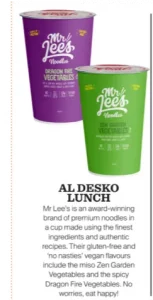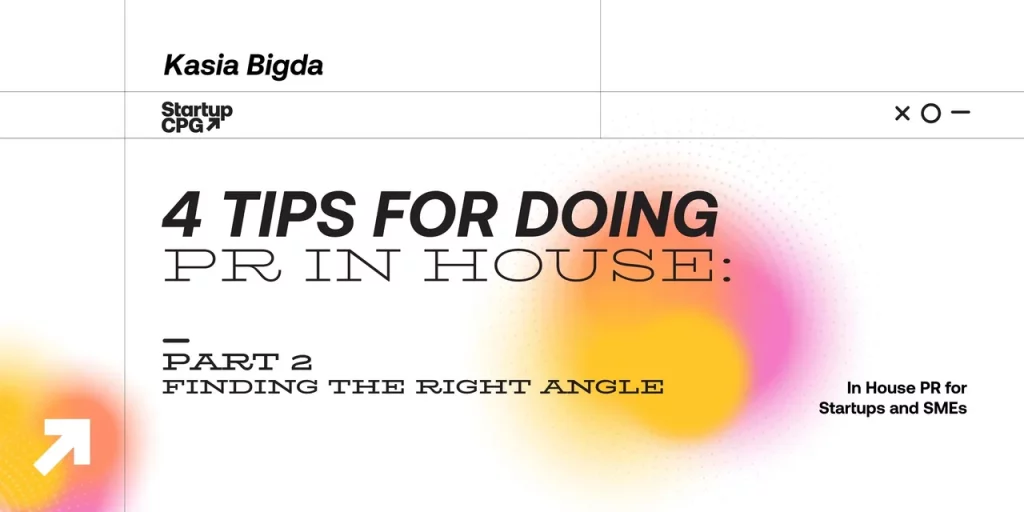4 Tips for Doing PR In-House –
Part 2: Finding the Right Angle
Kasia Bigda is the Marketing and Communications Director at Mr Lee’s Pure Foods – global food tech company. Prior to joining Mr Lee’s she worked at multiple digital marketing agencies focusing on SEO and content marketing. She loves traveling, nature and psychology.
I remember my first conversations with journalists in 2016. I didn’t have much expectations, as I was only just starting with PR and really didn’t know what would work. At Mr Lee’s, we contracted a freelancer to write our first press release, which was really helpful in showing me the way it was supposed to be done for my company. I was trying to pitch it to literally everyone then; the next few years I have significantly refined my approach and taught me a lot of valuable lessons which now I want to share with you.
Journalists will often happily feature your product if it fits the theme or the style of the section they are writing for, even if the products is not new, so don’t worry if you do not have any news (although they make your pitch much MUCH more successful) or have no time to write long form copy – there are still some options for you!
In my previous article with 4 tips of doing PR in-house I suggested you check out the names of the journalists who are writing for the sections you are “eyeing” for your feature. At the same time you can see the style of copy they are using there.
Knowing where you want to be featured will help you to find the right angle for your pitch. Here are some ideas on where to start:
 If they feature other brands with only around 30-50 words talking about their USPs, RRP, main retailer info and a link to the website, I have been sending exactly that to the journo – a print ready copy formatted to match their style to save them time or simply ignoring it all together. The example of it is usually a 1 full page with 5-10 brands collated under one theme eg. Shopping List, What’s Hot, Vegan Snacks, Food Trends, Winter Warmers…you get the picture. It is common for both B2B and B2C press. Example online here and print (page 10-11) here
If they feature other brands with only around 30-50 words talking about their USPs, RRP, main retailer info and a link to the website, I have been sending exactly that to the journo – a print ready copy formatted to match their style to save them time or simply ignoring it all together. The example of it is usually a 1 full page with 5-10 brands collated under one theme eg. Shopping List, What’s Hot, Vegan Snacks, Food Trends, Winter Warmers…you get the picture. It is common for both B2B and B2C press. Example online here and print (page 10-11) here
- If they do big interviews with brand owners, you can offer to interview you/your boss about the brand story, your USPs (if they are really unique), any different approach your company is taking, any opinionated piece about the niche you are in or provide them with some findings and case studies. Same idea applies to other people from the company – it does not always have to be the founder who has the voice. If the angle would better suit someone else from the company eg. operations and logistics manager about the supply chain issues during pandemic, then offer them for an interview. In my experience this angle is slightly more common in the B2B press. The interview can usually be done in 3 ways: over the phone/zoom or via a set of questions sent over an email to you to reply by the deadline or (very rarely) face to face. I have noticed that with all the interviews done in the past, the biggest/longest were the ones done over the phone or face to face. I think it may be due to the ability to build a personal relationship and for journo to be able to ask many more questions and get much more details from you. If you can choose, I would definitely recommend that!
- If they need a comment about some specific topic, ask for a quote from the expert in your company who can bring some opinion (usually around 100-200 words) – make sure it is useful for their audience and doesn’t sound like an advertorial, as it probably will not get published. It needs to bring something to the conversation! It is common for both B2B and B2C press. Here is an example of my reply about how covid affected our marketing and some short comment for Forbes about PR hacks. As you can see, it is all about sharing your experience and helping others to learn from it too.

- If they have a News section, they will be interested in product launches, new expansions, business announcements, fundraises etc. Basically what has been happening or is going to happen in the range of 1-3 months from now. That is where your press release can be very useful. In my opinion it is more common in B2B press, but the B2C press often has it’s equivalent which I have mentioned above in the first bullet. You can submit your press releases directly to the editorial team of a chosen publication and sites like Food Navigator or KamCity are making it very easy.
- Be reactive! This method had a much higher success rate for me, as you help the journo to find the material before the deadline. You need to be quick with it as often they need it very soon, so if you have your Media Kit ready, you can start! How to find it? There are several options depending on the country you are based on and your budget. Check out Help a Reporter Out (HARO), ResponseSource, SourceBottle and JournoRequest (which send you email following theTwitter hashtag #journorequest).
- There is also “the wire”, where you can upload your press release and it goes to multiple titles at the same time. I have not been using it much, but from the experience so far it has been a bit more successful in the USA than in the UK or Australia. It is not cheap and I had much more success with all the angles I described above, but I am sure there are some big advocates of it out there who would swear by it.
Hope it was helpful and gave you some ideas! More useful tips in my next article!






All Comments